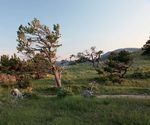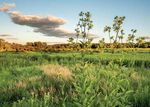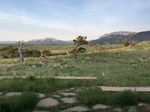BEAUTY WILD of the DARREL MORRISON
←
→
Page content transcription
If your browser does not render page correctly, please read the page content below
BEAUTY
of the
WILD
A LIFE DESIGNING LA NDSCA PES
INSPIR ED BY NATUR E
DARREL MORRISON
LIBRA RY OF A M ERICA N LA N DSCA PE HISTORY
A M H ERST, M ASSACH USETTSMesic prairie section with Curtis Prairie beyond, Native Plant Garden, University of Wisconsin–
Madison Arboretum. Photograph by Robert Jaeger.
Central vista, Native Plant Garden, UW Arboretum, showing wetland, mesic prairies, bur oak savanna (right), black oak sa-
vanna (left), and oak-hickory forest. Photograph by Robert Jaeger.
eloquently expresses this process of education, noting that “our ability to per-
ceive quality in nature begins, as in art, with the pretty. It expands through
successive stages of the beautiful to values as yet uncaptured by language.”2
For me, the next step involved thinking about the processes that led to pat-
terns: microenvironmental differences, varying means of reproduction, plant
migration, competition, and succession.
The text for the plant ecology class was John T. Curtis’s The Vegetation
of Wisconsin, published in 1959, shortly before his premature death. The book
Historic Greene Prairie restoration, UW Arboretum. Photograph by Darrel Morrison. is a lasting legacy, reflecting the author’s encyclopedic knowledge of Wiscon-
M erging Ecology with Design 41the proposed effort to establish large sweeps of native tall grasses to contrast
with broad curving “rivers” of mown turfgrass had the potential to reinforce,
and even intensify, the concept of Storm King as “one big overall sculpture.”
Although captivated by the prospect of working toward that ambitious goal, I
cautioned that it wouldn’t be quick and it wouldn’t be easy.
On our initial tour of the site that day, I noted that non-native weed spe-
cies thrived in all sunny areas that were not regularly mowed. We would be
fighting a battle with spotted knapweed in dry areas and purple loosestrife
in wet, poorly drained ones. From my experience on the farm, I knew that
weeds seemed to be suppressed in areas planted in the perennial forage crop,
alfalfa, for two or more years. Instead of plunging into a program of plant-
ing native grass mixes the next spring, I recommended seeding cover crops as
“placeholders,” and native grasses later. In spring 1997, upland sites would be
Islands of big bluestem, Canada wildrye, and Indiangrass with Alexander Liberman’s Adam (1970), Storm King Art Center. © 2020
The Alexander Liberman Trust. Photograph by Jerry L. Thompson. Courtesy Storm King Art Center.
left, Tal Streeter’s playful red vertical zigzag Endless Column. I continued on
as the driveway curved up Museum Hill, with a fifty-year-old planting of pines
with pole-like trunks on my right, and Kenneth Snelson’s Free Ride Home, a
composition of aluminum tubes with stainless steel cable, down a slope to my
left. At the top of the hill, I arrived at a Normandy-style chateau built in 1935,
now both a museum and the administrative building for the art center.
Storm King had been founded in 1960 by Ralph E. Ogden and H. Peter
Stern as a museum for Hudson River School painting, but by the following
year both had decided to focus on modern sculpture. William A. Rutherford
Sr., who had been involved in shaping the Storm King landscape from the be-
Peninsulas of native grasses in South Fields with Mark di Suvero’s Pyramidian (1987/1998) and Beethoven’s Quartet (2003),
ginning, once described the Art Center as “one big overall sculpture into which Storm King Art Center. Pyramidian, gift of the Ralph E. Odgen Foundation; Beethoven’s Quartet, courtesy Tippet Rise Art Center. © Mark di Suvero, courtesy the
you add other sculptures.” As David and Bill explained at our first meeting, artist and Spacetime C.C. Photograph by Jerry L. Thompson. Courtesy Storm King Art Center.
98 BEAU TY OF T H E W ILD ex panding horizons 99Long prairie vista with bluejoint grass in the wetland area, Native Plant Garden, UW Arboretum. Photograph by Susan Carpenter.
ciation process was not present. That year, I kept in touch with a realtor who
was on the lookout for land that might interest me. After locating many prop-
erties with deal-breaking drawbacks, she finally sent photos of a twenty-acre
parcel that seemed promising. Sixteen acres of the site were occupied by a rich
hardwood forest on a steep north-facing slope, which extended over a ridge
and partway down a south-facing slope, where paper birches and scattered
red cedars feathered into a rocky dry prairie. As I studied the photographs
from faraway Georgia, it was apparent that this was a high-quality natural
Prairie cordgrass with yellow coneflower in the wet-mesic prairie section, Native Plant Garden, UW Arbore- prairie remnant with all the “right” colors of little bluestem, side-oats grama
tum. Photograph by Susan Carpenter. grass, northern prairie dropseed, and Indiangrass. Once again, I was seduced
ex panding horizons 113from the original lot to the adjacent one, which was already in a semi-wild
state. An annual mowing program on that lot has revealed a traditional dry-
laid stone wall, a reminder of an agricultural past. A zone of aging forest trees
occupies the southern section of the site. From the edge of those woods, a new
cluster of fifty young, early-successional trembling aspens emerges into the
open field. Under the canopy of the old forest trees, twenty-five shade-tolerant
American beech saplings have been planted. One day, they will become a part
of the canopy, and their horizontal branches will retain their copper-turning-
to-tan leaves through the winter.
Neither of us is enamored with cultivars of native species and we agree
Early-successional species: daisy fleabane, wild bergamot, and black-eyed Susan, Round House. Photograph by Jonathan D. Lippincott. View to the Round House. Photograph by Jonathan D. Lippincott.
146 BEAU TY OF T H E W ILDjust outside my window. A perky striped chipmunk scurries across the rocky
ground, leaps effortlessly onto the cut stump of an ancient limber pine, and
suns himself on the warm, flat surface. A white butterfly flits by.
I step outside my room onto a raised stone terrace with two-inch-tall silver
sage plants and flat mats of pussytoes growing in the spaces between the gray
to brownish stone slabs. Over a decade has passed since I first designed these
terraces. I walk down five broad stone steps on the west side, past the clump of
crisp, rattling balsamroot leaves and the perky chipmunk’s sunny pine stump.
A two-foot-wide, dry-laid stone path winds through the clusters of dwarf
gnarly pines to the west. I remember how much fun it was to lay out that path,
Limber pines, balsamroot, and native grasses near the guesthouse, Montana ranch. Photograph by Carol Betsch.
placing colored flags through the clumps of pines, alternately in the open, then
enclosed in a small pine grove, and then out into the open again. Sunlight and
shadow, prospect and refuge. The curves in the narrow path are not broad,
river-like curves but those of a winding stream. There is a bit of mystery where
low-branched pines partially block the view and then open up to reveal blue-
gray mountain peaks on the distant horizon. Next, a rustic circular wall is re-
View of the native landscape from the guesthouse terrace, Montana ranch. Photograph by Carol Betsch. vealed, a council ring, twelve feet in diameter with a three-foot-wide entrance
154 BEAU TY OF T H E W ILD under a Montana Sk y 155You can also read



























































